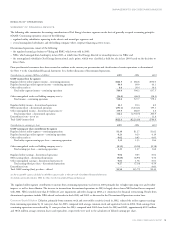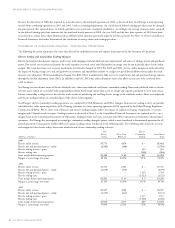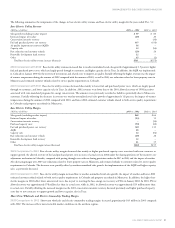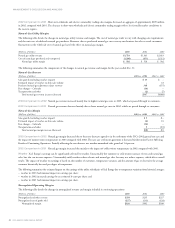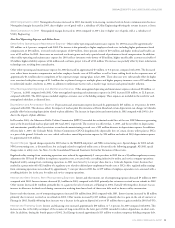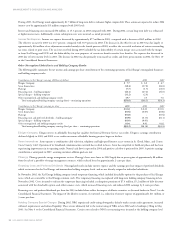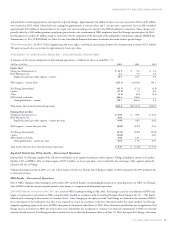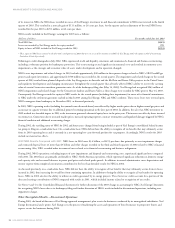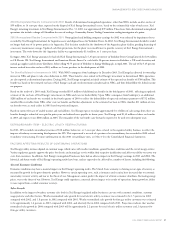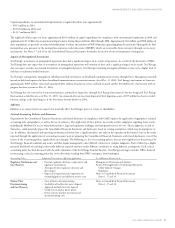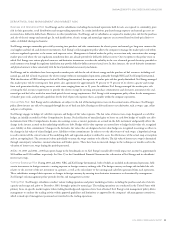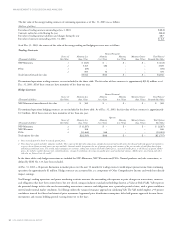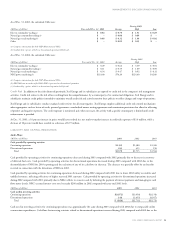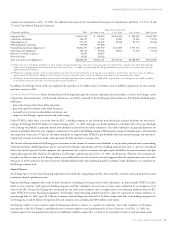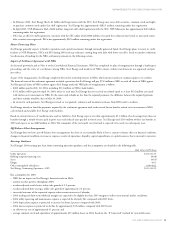Xcel Energy 2003 Annual Report Download - page 13
Download and view the complete annual report
Please find page 13 of the 2003 Xcel Energy annual report below. You can navigate through the pages in the report by either clicking on the pages listed below, or by using the keyword search tool below to find specific information within the annual report.MANAGEMENT’S DISCUSSION AND ANALYSIS
XCEL ENERGY 2003 ANNUAL REPORT 29
these projected funding requirements, PSCo elected to make a voluntary contribution of $30 million to its pension plan for bargaining employees in
2003, and it plans to voluntarily contribute another $10 million to the plan in 2004.
Regulation
Xcel Energy, its utility subsidiaries and certain of its nonutility subsidiaries are subject to extensive regulation by the SEC under the PUHCA with respect
to issuances and sales of securities, acquisitions and sales of certain utility properties and intra-system sales of certain goods and services. In addition, the
PUHCA generally limits the ability of registered holding companies to acquire additional public utility systems and to acquire and retain businesses
unrelated to the utility operations of the holding company. See further discussion of financing restrictions under Liquidity and Capital Resources.
Xcel Energy’s utility subsidiaries also are regulated by the FERC and state regulatory commissions. Decisions by these regulators can significantly
impact Xcel Energy’s results of operations. Xcel Energy expects to periodically file for rate changes based on changing energy market and general
economic conditions.
The electric and natural gas rates charged to customers of Xcel Energy’s utility subsidiaries are approved by the FERC and the regulatory commissions in
the states in which they operate. The rates are generally designed to recover plant investment, operating costs and an allowed return on investment. Xcel
Energy requests changes in rates for utility services through filings with the governing commissions. Because comprehensive rate changes are requested
infrequently in some states, changes in operating costs can affect Xcel Energy’s financial results. In addition to changes in operating costs, other factors
affecting rate filings are sales growth, conservation and demand-side management efforts, and the cost of capital.
Most of the retail rates for Xcel Energy’s utility subsidiaries provide for periodic adjustments to billings and revenues to allow for recovery of changes in
the cost of fuel for electric generation, purchased energy, purchased natural gas and, in Minnesota and Colorado, conservation and energy-management
program costs. In Minnesota and Colorado, changes in purchased electric capacity costs are not recovered through these rate-adjustment mechanisms. For
Wisconsin electric operations, where automatic cost-of-energy adjustment clauses are not allowed, the biennial retail rate review process and an interim
fuel-cost hearing process provide the opportunity for rate recovery of changes in electric fuel and purchased energy costs in lieu of a cost-of-energy
adjustment clause. In Colorado, PSCo has an interim adjustment clause that allows for recovery of all prudently incurred electric fuel and purchased
energy expenses in 2003. In 2004, PSCo generally is expected to recover all prudently incurred electric fuel and purchased energy costs through an
electric commodity adjustment clause. Additionally, this fuel mechanism also has in place a sharing among customers and shareholders of certain fuel
and energy costs, with an $11.25 million maximum on any cost sharing over or under an allowed electric commodity adjustment formula rate, and a
sharing among shareholders and customers of certain gains and losses on trading margins.
Xcel Energy’s utility subsidiaries make substantial investments in plant additions to build and upgrade power plants, and expand and maintain the
reliability of the energy distribution system. In addition to filing for increases in base rates charged to customers to recover the costs associated with
such investments, in 2003 approval was obtained from Colorado and Minnesota regulators to recover, through a rate surcharge, certain costs to
upgrade plants and lower emissions in the Denver and Minneapolis-St. Paul metropolitan areas. These rate recovery mechanisms are expected to
provide significant cash flows to enable recovery of costs incurred on a timely basis.
Regulated public utilities are allowed to record as regulatory assets certain costs that are expected to be recovered from customers in future periods
and to record as regulatory liabilities certain income items that are expected to be refunded to customers in future periods. In contrast, nonregulated
enterprises would expense these costs and recognize the income in the current period. If restructuring or other changes in the regulatory environment
occur, Xcel Energy may no longer be eligible to apply this accounting treatment, and may be required to eliminate such regulatory assets and liabilities
from its balance sheet. Such changes could have a material effect on Xcel Energy’s results of operations in the period the write-off is recorded.
At Dec. 31, 2003, Xcel Energy reported on its balance sheet regulatory assets of approximately $572 million and regulatory liabilities of approximately
$1.2 billion that would be recognized in the statement of operations in the absence of regulation. In addition to a potential write-off of regulatory
assets and liabilities, restructuring and competition may require recognition of certain stranded costs not recoverable under market pricing. See Notes 1
and 19 to the Consolidated Financial Statements for further discussion of regulatory deferrals.
PSCo 2002 General Rate Case In May 2002, PSCo filed a combined general retail electric, natural gas and thermal energy base rate case with the
CPUC as required in the merger approval agreement with the CPUC to form Xcel Energy. On April 4, 2003, a comprehensive settlement agreement
was reached, which addressed all significant issues in the rate case. In mid-2003, the CPUC approved the final settlement, which provided for:
–a decrease in annual base rates of approximately $33 million for natural gas and $230,000 for electricity, including an annual reduction to electric
depreciation expense of approximately $20 million, effective July 1, 2003;
–an interim adjustment clause (IAC) that fully recovers prudently incurred 2003 electric fuel and purchased energy expense above the expense
recovered through electric base rates during 2003;
–a new electric commodity adjustment clause (ECA) for 2004 through 2006, with an $11.25 million cap on any cost sharing over or under an allowed
ECA formula rate; and
–an authorized return on equity of 10.75 percent for electric operations and 11.0 percent for natural gas and thermal energy operations.


